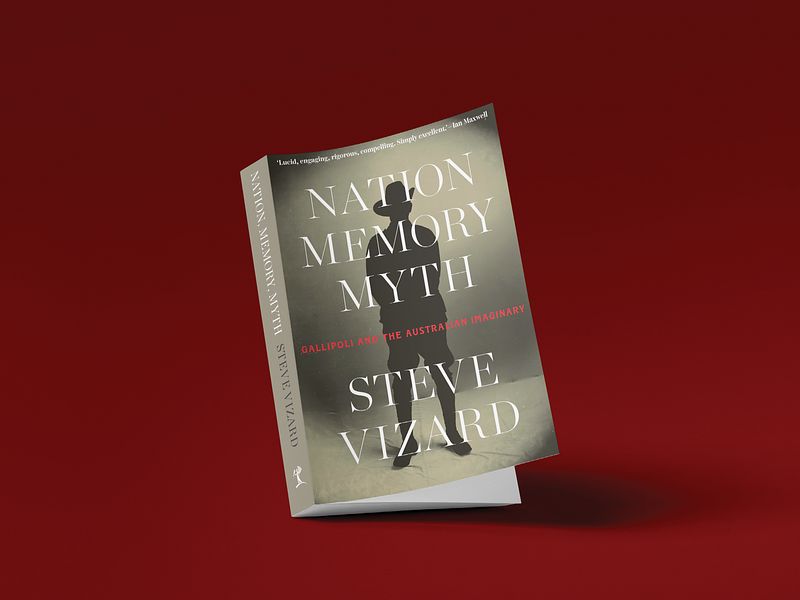Extract: Nation, Memory, Myth by Steve Vizard
Contesting the Myth

How does myth generate meaning for a nation and its citizens? How does a national myth transform into symbolic performances of cultural memory and kinship?
In his compelling book, prizewinning writer, broadcaster, lawyer and research professor Steve Vizard delves into the role Gallipoli mythology has played in creating Australia’s national values and identity. Offering an original perspective, Nation, Memory, Myth challenges readers to consider how Gallipoli mythology has changed over time and what an Australia in the 21st century might mean.
In the extract below, Vizard examines how Australians perceive Anzacs and Anzac Day and looks at the potential problems and pitfalls of Gallipoli as Australia’s foundational myth.
In the words of former Australian Prime Minister Bob Hawke, ‘Gallipoli was really the birthplace … of our spirit of nationhood’. Another former Prime Minister, Tony Abbott, echoes Hawke’s sentiments: ‘The First World War impacted on Australia like nothing else before or since. It was the crucible that forged our nation’.
Media commentators, editorialists, civic leaders – even many historians who criticise Gallipoli’s disproportionate influence in shaping Australia’s discourses of national identity – concede, many reluctantly, that ‘Anzac is Australia’s “most powerful myth of nationhood”’. Gallipoli ‘goes beyond the commemoration of war, ultimately serving as the key moment of celebration of the Australian nation and national values’. For Stanley, ‘in the first decade of the twenty first century, far from eroding, Anzac Day is entrenched as the de facto national day, eclipsing an Australia Day.’
Quantitative research affirms that almost all Australians associate Anzac with Australian national identity; and that Anzacs play ‘by far’ the most significant role in relation to contemporary Australian identity. Anzac Day is viewed as Australia’s pre-eminent commemorative event, as ‘the only special day with any significant meaning’. Their research concludes that there is ‘relatively little social or demographic variation in the way Australians view Anzacs – almost everyone agrees that Anzacs influence the way Australians see themselves’. Indeed, they report that the admiration for the Anzacs in Australia ‘is comparable to the prestige and reputation of Abraham Lincoln in America’.
The myth of Gallipoli is a performative representation of supremacy. Gallipoli acts as a demarcation of Australian exceptionalism. It signifies the nation’s boundaries between right and wrong, permissible and forbidden, home and away; and, most critically, us and them. In creating the boundaries of Self, the myth marks the Other.
Like other forms of constructed social identity, the national myth acts as ‘that part of the individual’s self-concept which derives from his knowledge of his membership of a social group, together with the value and emotional significance attached to that membership’. The Gallipoli myth is laden with potent markers of Australian exceptionalism and belonging.
Yet Gallipoli, like all national foundation myths, is slippery. It constantly negotiates the tension between asserting inviolability and fixity, while absorbing, adopting and adapting the discursive transfers and flows of ideologies and beliefs from evolving cultural, social and spatial settings. It appears timeless and unchanging, yet demonstrates unending porosity and hybridity – continually budding diverse reimaginings of nationhood. It operates less as a narrative of chronological events, and more as a carrier of Australia’s essential national values, beliefs and ideology. It matters less that Gallipoli is verifiable; more that it is believed, and even more that it is felt.
Adding to the complexity of interpreting Gallipoli as Australia’s foundation myth is the need to understand it not merely as a single discrete story, but as a living strand of a complex, intertwined corpus of ‘culturally important, imaginal stories, conveying by means of metaphoric and symbolic diction, graphic imagery, and emotional conviction and participation, the primal, foundational accounts of aspects of the real, experienced world and humankind’s roles and relative statuses within it’. In this sense, Gallipoli is not ‘a free-standing expression of the national Culture’ but forms part of an ‘elaborate scaffolding of … structures, myths, and memories’. Like all nations, Australia has its own unique but complex living matrix of mythic narratives, meta-narratives and derivative myths, which variously feed into and enliven each other. These range from meta-narratives of a convict nation, white colonisation, terra nullius and related myths of a vast and empty continent that swallows humanity, and of a distortion of European civilisation, and rugged individualism in the face of adversity; to those of a welcoming new utopia. Adding to the complexity of these traditional narratives is a raft of opposing, competing and seemingly incompatible narratives: of a European nation in Asia, of White Australia, or of violently dispossessed First Nations.
Within this matrix, Gallipoli performs as Australia’s originary myth, analogous to Turner’s root paradigms or core narratives, in a complex symbiotic web, feeding all Australian mythic narratives (secondary and derivative), collectively and actively interacting to provide a living architecture of the national imaginary. Gallipoli functions as the nation’s ‘big story’, relating not only the mythical origins of the Australian nation, but also its ‘class, religion, race … the identity of the we – community as well as that of its enemies’.
- Share
- Posted On 11 Jun 2025
